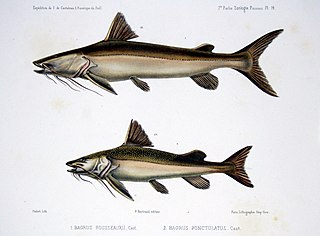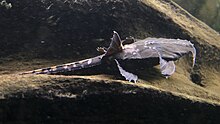
Catfish are a diverse group of ray-finned fish. Named for their prominent barbels, which resemble a cat's whiskers, catfish range in size and behavior from the three largest species alive, the Mekong giant catfish from Southeast Asia, the wels catfish of Eurasia, and the piraíba of South America, to detritivores, and even to a tiny parasitic species commonly called the candiru, Vandellia cirrhosa. Neither the armour-plated types nor the naked types have scales. Despite their name, not all catfish have prominent barbels or "whiskers". Members of the Siluriformes order are defined by features of the skull and swimbladder. Catfish are of considerable commercial importance; many of the larger species are farmed or fished for food. Many of the smaller species, particularly the genus Corydoras, are important in the aquarium hobby. Many catfish are nocturnal, but others are crepuscular or diurnal.

Callichthyidae is a family of catfishes, called armored catfishes due to the two rows of bony plates along the lengths of their bodies. It contains some of the most popular freshwater aquarium fish, such as many species in the genus Corydoras.

The Pimelodidae, commonly known as the long-whiskered catfishes, are a family of catfishes.

The Ariidae or ariid catfish are a family of catfish that mainly live in marine waters with many freshwater and brackish water species. They are found worldwide in tropical to warm temperate zones. The family includes about 143 species.

Erethistidae are a family of catfishes that originate from southern Asia. It includes about 45 species.

Callichthys callichthys, the cascarudo, armored catfish, bubblenest catfish, hassar, or mailed catfish, is a subtropical freshwater fish belonging to the subfamily Callichthyinae of the family Callichthyidae.

Brachyplatystoma is a genus of catfish from the family Pimelodidae. As the occasionally used common name goliath catfishes indicates, this genus includes some of the largest species of catfish, including the piraíba, B. filamentosum, which reaches up to the region of 3.6 metres (12 ft) in length. Brachyplatystoma are found in the Amazon and Orinoco basins, and other tropical freshwater and brackish habitats in South America. Some species are migratory. These fish are important as food fish and, to some extent, aquarium fish.

Hemiancistrus is a genus of suckermouth armored catfishes. These species are native to South America. The taxonomy of this genus is complex and unclear, and major work has to be done. Many of these fish are popular aquarium fish.
Acanthobunocephalus nicoi is one of two species of catfish in the genus Acanthobunocephalus of the family Aspredinidae. This species is known from only three localities and appears to be restricted to the upper Orinoco River system of Venezuela and possibly the upper Rio Negro system of Brazil.

Platystacus cotylephorus, the banded banjo, is a species of banjo catfish. It is the only member of its genus. The genus Platystacus is the sister group to a clade containing Aspredo and Aspredinichthys. P. cotylephorus originates from coastal waters and lower portions of rivers of northern South America, from Venezuela to northern Brazil.
Aspredinichthys is a genus of banjo catfishes found in fresh and brackish waters in tropical South America from the Orinoco delta, through the Guianas, to the Amazon delta. Both species are found in lower portions of rivers and in coastal waters of northern South America from Venezuela to northern Brazil where they are benthic fish.
Pterobunocephalus is a genus of banjo catfishes found in tropical South America.
Hoplomyzon is a genus of banjo catfishes that are native to tropical South America.
Xyliphius is a genus of banjo catfishes from South America.
Micromyzon akamai is a species of catfish in the family Aspredinidae.
Micromyzon is a genus of tiny catfish in the family Aspredinidae native to relatively deep parts of the Amazon and Orinoco basins in South America.

Bunocephalus is a genus of banjo catfishes from South America. It is found in Magdalena, Orinoco, Amazon, Paraguay-Paraná, and São Francisco Rivers. It is also the only aspredinid genus found west of the Andes, found in the Atrato, San Juan, and Patía Rivers. This genus is a part of the family Aspredinidae, known as banjo catfishes for their large, flattened heads and slender tails that give the appearance of a banjo. Most species exhibit cryptic coloration, and the same holds true among Bunocephalus species. The skin is completely keratinized and is covered by large, unculiferous tubercles. Bunocephalus species may reach up to 13 centimetres SL.

Pseudobunocephalus is a genus of banjo catfishes.
Amaralia hypsiura is a species of catfish of the family Aspredinidae. A. hypsiura are found throughout the Amazon River basin. They are medium-sized aspredinids. These fish have a deep, laterally compressed caudal peduncle, a reduced dorsal fin with only 2–3 rays, and well-developed head ornamentation.
Micromyzon orinoco is a species of catfish in the family Aspredinidae.











